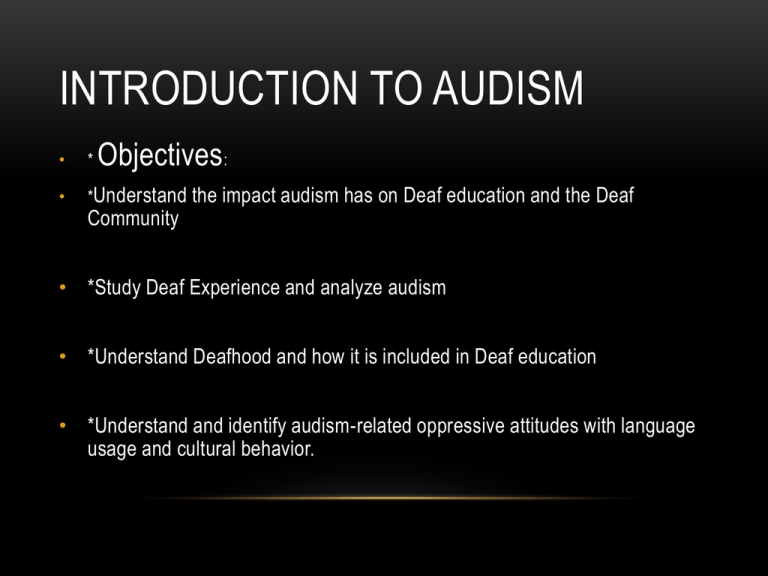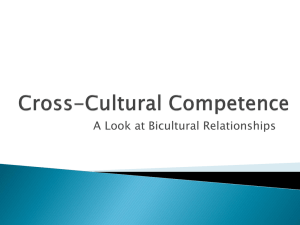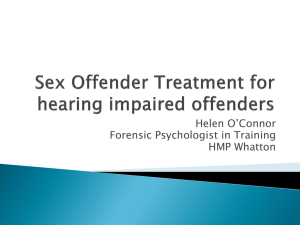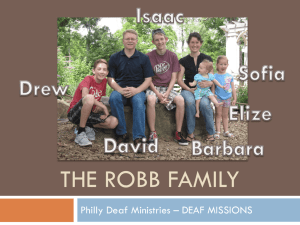
INTRODUCTION TO AUDISM
Objectives:
•
*
•
*Understand the
Community
impact audism has on Deaf education and the Deaf
• *Study Deaf Experience and analyze audism
• *Understand Deafhood and how it is included in Deaf education
• *Understand and identify audism-related oppressive attitudes with language
usage and cultural behavior.
ANY QUICK ANSWERS?
• *How many of you know the word?
• *How is it defined?
• *Where do you find audism?
• *How can Deaf people be audist?
• *Why and how did audism come to exist?
• *Why study about audism?
• *What are the long term effects of audism on Deaf people?
• *How can we diminish audism in our society?
AUDISM UNVEILED VIDEO
•
* We
will watch a 50 minute video called “Audism Unveiled.” You
will be given a worksheet that you must complete after the
video. I know it is difficult to remember all details in the 50
minute video, so you will be allowed to take notes on
information you feel is important. You will be able to use your
notes as you and your group members discuss what you feel
are the correct answers. All group members must take notes so
they can contribute in the completion of the worksheet.
UNDERSTANDING AUDISM
• *How can racism be understood in a world of same race or sexism in a world
of same sex?
• *You must have an oppressed minority and their experience around you or in
your system before you understand the dynamics of oppression.
• *Why don’t some women trust men?
• *Why don’t some black people trust white cops?
• *Why don’t some Deaf people trust hearing professionals?
• The bottom line: “To understand audism, we must study Deaf experience
and include it in deaf education.”
DEAF EXPERIENCE
• “What is Deaf experience?”
• *Family—hearing, deaf, signing, speech, support?
• *School—Deaf Institute or Public Education?
• *Society—What is their position? How are they treated?
• *Religion—Access, Lack of access, parental involvement, Deafhood in
Church.
• “Definition of Experience”: “A rich history of wisdom of Deaf culture
expressed and preserved through ASL literature, poetry, art, storytelling
passed from generation to generation through gatherings such as Deaf
clubs, churches, sports, and other types of gatherings.”
ISSUES WITH DEAF AMERICANS
• *Lack of full access communication with parents.
• --2006: 69% family members do not sign.
• --2007: 70% family members do not sign.
• --2008: 71% family members do not sign.
• Source: Gallaudet Research Institute
• *Lack of acceptance of being a Deaf person in the hearing society.
• *Lack of support for their rights to use sign language.
• *Struggle to find place in hearing society and even Deaf community.
Eventually become isolated.
• *Accepts audism
AMERICAN DEAF EDUCATION
Bilingual Dominant
Oralism Dominant
Learn ASL natural language first, then
learn to read and write English. By doing
so it creates:
Learn to speak, read and write in English
instead of learning ASL. It creates:
Self esteem- can code switch with hearing
and Deaf. More communication modes &
power.
Strong social development in both hearing
and Deaf communities.
Gain self identity and bi-cultural
awareness.
Frustration due to unnatural language
acquisition, lack of teaching resources,
dependence on speech and hearing
modes. Often deaf forced into oral learn
ASL as adults but never reach native level.
Social development depends on teachers
and peers’ patience and attitudes.
Confused self identity. Unsure about self.
Struggle socially with weak self identity.
DEFINE “AUDISM”
• Take a moment with a partner and come up with a short definition for what
you think the definition for Audism might be.
AUDSIM DEFINITION BY “TOM
HUMPHRIES” 1977
• “The notion that one is superior based on one’s ability to hear or behave in
the manner of one who hears.”
• He manifests his definition…..
• Audism appears in the form of people who continually judge deaf people’s
intelligence and success on the basis of their ability in the language of the
hearing culture. It appears when the assumption is made that the deaf
person’s happiness depends on acquiring fluency in the language of the
hearing culture. It appears when deaf people actively participate in the
oppression of the other deaf people by demanding of them the same set of
standards, behavior, and values that they demand of hearing people. ( Journal of
Deaf Studies and Deaf Ed. 2004)
THE CORPORATE INSTITUTION
• Deal with deaf people by making statements about them, authorizing views
of them, describing them, teaching about them, governing where they go to
school, and in some cases where they live.
• …In short, audism is the hearing way of dominating, restructuring, and
exercising authority over the deaf community. It includes such professional
people as: administrators of schools for the deaf children and of training
programs for deaf adults. Interpreters, audiologists, speech therapists,
hearing aid specialists, social workers, and psychologists.
MORE AUDSIM DEFINITIONS:
• *An attitude based on pathological thinking which results in negative stigma
toward anyone who does not hear, like racism or sexism, audism judges,
labels, and limits individuals on the basis on whether a person hears and
speaks. Humphrey and Alcorn, 1995
• *A system of advantage based on hearing ability.
• *A metaphysical orientation that links human identity with speech.
Bahan and
Bauman 2000
• Prevalent logic: Speech = language, Language = human (to differ from
animals) therefore to be human, you have to speak.
SUMMARIZATION OF DEFINITIONS
• 1. Notion that one is superior based on one’s ability to hear.
• 2. A system of advantage based on hearing.
• 3. Metaphysical system that links human identity with speech.
• What is the common denominator of audism?
BEHAVIORS THAT SHOW AUDISM
• 1. Jumping to help a deaf person communicate.
• 2. Asking a Deaf person to read your lips or write when they indicate it is not
their preference to do so.
• 3. Making phone calls for a deaf person since they “can’t.”
• 4. Refusing to call an interpreter when one is requested.
• 5. Assuming that those with better speech/English skills are superior over
ASL signers.
• 6. Asking a Deaf person to “tone down” their facial expressions because they
are making other people uncomfortable.
BEHAVIORS THAT SHOW AUDISM
CONTINUED….
• 7. Refusing to explain to a Deaf person why everyone around him is
laughing- “never mind, I will tell you later, it doesn’t matter.”
• 8. Developing a significant amount of instructional time for a Deaf child to lipread and speech therapy, rather than on educational subjects.
• Can you think of any more?........
EFFECTS OF AUDISM ON DEAF
• *Education—same ed as hearing?
• *Employment—same opportunities?
• *Economy—Position in society?
• *Deaf Culture Damage—forced speech eliminate ASL?
• *Psychological/Mental Health—ex How to deal with isolation from family,
school, work, society etc.
AUDISM MYTHS
•
* It is hearing people’s problem. Deaf people don’t have audism.
• *Audism is obvious.
• --Dysconscious audism: A form of audism that totally accept dominant
hearing norms and privileges.
*DA denies people full acceptance of ASL.
• *It is belief in the importance of English.
• *Tolerance for different choices of communication methods with
individuals.
--DA weakens development of Deaf ID
*Accept hearing impaired, disabled, and don’t fight back against audsism
WHERE IS AUDISM?
•
•
•
•
•
•
•
•
•
1. Educational System
2. Hospital and Medical Community
3. Government and Legal System
4. Work
5. Service agencies and businesses
6. Family
7. Deaf Community
8. Hearing and Deaf populations
9. Others?
HOW CAN WE DIMINISH AUDISM IN
OUR SOCIETY?
1.Diversity workshops/training
2.Learn about the effects Audism has on Deaf and spread the knowledge.
3. Educational systems need to be changed.
4. Media and textbooks need to include Deaf culture, audism, ASL, etc. to
spread public awareness and accurate picture of Deaf people. Learn the history
so you don’t repeat it.
5.What can YOU do individually to diminish Audism???????
PART 2: “UNDERSTANDING DEAFHOOD”
• * What is Deafhood?
• * Compare this with these words, “Childhood,
Motherhood, Boyhood”
• * Compare with “Deafness”
• * What is the sign for “Deafhood”
DEAFNESS VS. DEAFHOOD
• * Deafness: Is a focus on the inability to hear and ways of
“fixing” it through hearing technology. It is also a mental
framework that guides the deaf child’s development with a
medical perspective.
• *Deafhood: Is a progress of self-actualization and
establishing a Deaf identity through life events that shape
one’s view of self as a Deaf person and their role in the Deaf
community.
MORE COMPARISONS
• DEAFNESS
• DEAFHOOD
• Medically oriented term, a
state
• A process, not a state
• Condition
• Cultural & Linguistic
Minority
• Abnormality
• Normality
• Individualism
• Collectivism
• Diagnosed
• Recognized
• Handicap
• Beliefs / Values
STAGES OF DEAFHOOD
• 1. Oppression
• 2. Examination
• 3. Liberation
• 4. Empowerment
• 5. Activism
OPPRESSION AND DEAF IDENTITY
• Audism- “You are not like hearing people.”
• Linguicism- “You do not speak in our language.”
• Discrimination- “You are different; you cannot do it.”
• Deafism- “You are not Deaf enough.”
• Specialism- “You need more help and attention.”
• Intellectualism- “You are not smart enough.”
• Paternalism- “I’ll do it for you.”
FIGHTING BACK AGAINST OPPRESSION
• Counteracting the terms……
• Audism- “I am Deaf. I am ok.”
• Linguicism- “I can sign ASL fluently.”
• Discrimination- “ I can do it.”
• Deafism- “I respect all cultures.”
• Specialism- “I am like all people.”
• Intellectualism- “ I can learn.”
• Paternalism- “ I want us to work together.”
“HEARING PRIVILEGES”
• 1. A system that is designed to give hearing people a power
to do things their way without question, struggle or
challenge.
• 2. Whatever hearing professionals say, the hearing parents
will listen to them in spite of the amount of advice or
powerful arguments from the Deaf people with Deaf
experience.
• 3. Hearing privileges can be positive or negative depending
on how you use your power in Deaf education.
EMPOWERMENT
• “Once I learned that ASL is my native language, I developed
a strong sense of identity as a deaf person and a more
positive self-image.” –Barbara Kannapell (Deaf Heritage)
• “To know, once and for all, that our “primitive” and
“ideographic gestures” are really a formal language on a
par with other languages of the world is a step toward pride
and liberation.”- Mervin D. Garreston (Deaf Heritage)
HISTORY OF EMPOWERMENT AND ACTIVISM IN
THE DEAF COMMUNITY
1880-National Association of the Deaf-1880-civil rights org.
1951-World Federation for the Deaf-international non-gov org
1955-William Stokoe and ASL dictionary of linguistics principles
1988-Deaf President Now-Gallaudet protest for Deaf pres.
1989,2002-Deaf Way 1, 2-conference
2006-Unity for Gallaudet (second protest)
2007-Deaf Bilingual Coalition-rights for deaf to use ASL
2008- Audism Free America-unmask audism in media, equal
rights,challenge ideologies
• 2010-Deaf Hate Crime Lectures
•
•
•
•
•
•
•
•
HEALTHY DEAFHOOD AND DEAF IDENTITY
DEVELOPMENT FOR DEAF CHILDREN
• Acceptance of individual’s deafness
• Experience a natural acquisition of a visual language, ASL
• Bilingual-Bicultural (Bi-Bi) education with Deaf experience in
curriculum
• Appropriate (audism free and linguicism free) environment for social
development with other deaf children who uses ASL.
• Deaf adults as role models including teachers, community members,
professionals, etc.
• Has his/her own belief system and Deaf Identity established through
Deafhood process.
PART 2 END: QUOTE BY LAURENT CLERC
• “A day when deaf people and their language are
completely accepted—no, more than that, truly
welcomed—as a part of the family of man, in which
God created diversity not to oppress the minority
who are different, but to enrich the lives of all.”
AUDISM PART 3: “LANGUAGE AND CULTURAL
ATTITUDES IN EDUCATION”
• How does this apply to teachers?
• “…the educator of the deaf must learn through the
experience of the educated deaf wherein to modify and
improve his methods.” –Enoch Currier (Deaf Heritage)
SITUATION AND QUOTATION ANALYSIS:
AUDISM? LET’S HAVE A GROUP DISCUSSION….
• 1. “It’s a hearing world”
• 2. “The Deaf boy is smart.”
• 3. “BETTER ASK HEARING”…(for English etc)
• 4. “Speech skills will help you succeed in life”
• 5. “Deaf are incapable to reason” Aristotle 450 BC
• 6. “Deaf people are not ready to function in hearing world”
Bassett Spilman 1988 DPN Protest at Gallaudet University
• 7. At a deaf children camp: Deaf hired to babysit deaf children
while hearing professionals hired to teach parents about deaf
children.
SITUATION AND QUOTATION ANALYSIS
• Media industries ignoring demands to put captions in their TV
programs
• Singing hearing songs in Deaf Schools (i.e. Christmas songs)
• No ASL assessment needed for teachers for the deaf or even deaf
students
• Being little behind with English skills compared with hearing
peers, but “he still is doing excellent as a deaf student.”
• Deaf community have no say or influence on local deaf
education. Why don’t we have a deaf ed. Advisory committee with
Deaf experts?
AUDSIM: TEACHING S.E.E IN SCHOOLS.
• Do Deaf students really learn English by signing S.E.E?
• Does SEE really make concepts clear?
• Does teaching in ASL make learning English harder?
• Is this language prejudice?
EXAMPLES OF WHY S.E.E CAN MISREPRESENT
MEANINGS AND CONTENT
• I am running
• I am running a meeting
• I am running for president
• My nose is running
• Engine is running
• The elevator isn’t running
• I need to run some errands
• A run on your panty hose
ENGLISH
TABLE OF COMPARISONS
SEE
• Language
System not language
Language
• Dynamic
Can expand but frozen
Dynamic
• Inflections, mood,
None
• Tone
ASL
Facial expressions
Semantics
• Cultural Identity
None
Cultural Identity
• Community
Very Limited
Community
• Natural
Not natural
Natural
• Literature, drama
None
Literature, drama
• Folktales, poetry etc.
Folktales, poetry etc.
AUDISM WITH HEARING TECHNOLOGIES
• 1. Receiving cochlear implants
• 2. Giving (forcing?) deaf children to receive cochlear implants
• 3. Removing cochlear implants. (Deafism?)
• 4. Deaf culture adults accepting CI
COCHLEAR IMPLANT AND AUDISM
• You cannot compare a technological device with a philosophy or
attitude. But many Deaf people associate CI with audism. Why?
• There’s a lot of audism motives, money politics, pathological
mentality with the push for C.I on the deaf children. The
dilemma is that the child has no choice but they benefit best
from CI at early age.
• Hearing professionals often strongly recommend separating CI
children from deaf school to be taught exclusively in an oralism
environment.
DOES THIS MAKE SENSE?
• Research shows that if hearing babies learn sign first, they will
be ahead with language development. As this concept becomes
very popular, why are deaf babies still denied this right for
natural language acquisition? In order to receive speech training
for the sake of hearing parents and audiologists who chose the
most difficult and frustrating way of teaching children education
Oralism which often result in a delay in language and social
development?
ATTITUDES AFFECT AUDISM?
• An attitude of superiority that influences one’s perspective,
attitude, or action toward other people according to a level of
belonging to Deaf Culture.
• “Deaf Elites”
• “Not Deaf Enough”
• Deaf in family or number of deaf generations = Deaf status or
authority in Deaf culture.
• “Deaf Power”
WHAT FORM OF OPPRESSION?
• I want to marry a Deaf woman.-Deafism?
• I want deaf children.-Deafism?
• I prefer to be with Deaf people.-Deafism/Discrimination
• You have to be Deaf to understand? Deafism/Discrimination
• Taking cochlear implant off for good? Deafism/Audism
CONTRIBUTIONS OF DEAF STUDIES TO OUR
WORLD
• Anthropology: Culture can be global
• Disability: Deaf studies changed the worldview on
“disability”.
• Visibility orientation broads our view of the world and
accessibility to technology.
• Philosophical challenge to the ancient question: What it
means to be a human?
INTEGRATING DEAF EXPERIENCE IN EDUCATION
• How can schools include them in the curriculum?
• ASL
• ASL storytelling / poetry
• ASL literature / drama
• Deaf Art
• Deaf History
• Deaf Studies
HOW LEARNING ASL IS BENEFICIAL
• Studying another language will help you with your first
language.
• Bilingual studies prove that two languages improves code
switching in your brain. More flexibility and thinking power.
• Hearing babies are known to get ahead with language
development when they begin with signs. Why not try that
with Deaf babies?
• Teaching gestures first before teaching ASL. Why? Teaches
more communication modes and skills.
DEAF CULTURE AS GLOBAL
• Deaf cultures around the world have similarities…..
• Gathering of Deaf people through long history
• Gesture based communication
• Collectivism type society
• Stories and folk-tales dealing with Audism and Oralism
• Deaf heroism and “strike back” stories are common
• Deaf/Deaf marriages preferences
QUOTES FROM THE DEAF COMMUNITY
• “Sign language was God’s noblest gift to deaf people.”George Veditz
• “There is no danger of sign language disappearing. It will
live long after you and I are dead. If we were all to die
tonight, a hundred years from now it would be still alive and
serving the deaf.”-John W. Jones
• “What is it like to “hear” a hand? You have to be deaf to
understand.”-Willard Madsen
MORE DEAF COMMUNITY QUOTES
• “Hearing and speaking does not make you smart, learning
and understanding does.”-Gilbert Eastman
• “The aim of the education of the deaf should be to make
him a well-balanced individual and not a pale imitation of a
hearing person…”-Dr. Rudolph Pintner
• “..the study of sociolinguistics made me realize that in
order to study a language one must understand the people
to use it.” “..a person can know and use English without
being able to speak it.”-Barbara Kannapell
PART 4: DEAF LABELS
• Deaf and Dumb
Hard of Hearing
• Deaf Mute
Deaf
• Hearing Impaired
• Hearing Handicapped
• Hearing Challenged
• Hearing Disabled
• Hearing Defective
• Cant Hear
DEAF DUMB
• Deaf perspective: Great Granddaddy of all negative
labels
• Based on misconception that deafness caused the
inability to speak—if you were deaf, there was also
something amiss with your capacity for speech
(and, if followed, if you couldn’t speak, you had no
language and couldn’t reason). It is a vulgar term
and is insulting. www.deaflife.com
DEAF MUTE
• Definition: Person who is unable to hear and speak.
• Deaf perspective: Deaf people resented the grandiose
claims that all deaf people could be made to speak and
clung to term to emphasize political stance: “We are deaf,
we use sign language, and we refuse to be forced to speak.
Thus it was seen as acceptable term. Then what was once
a reasonable term became degrading because it changed
from “proud non-speaking deaf signer” to “can’t talk.” It
carries negative connotation, suggesting pathetic, mentally
backward, helpless, hapless, or uneducated. It emphasizes
abnormality. www.deaflife.com
HEARING IMPAIRED
• Definition: Having reduced or deficient hearing ability.
Having defective sense of hearing but not deaf.
• Deaf perspective: Defines deaf people solely in terms of
broken or defective ears. It is a narrow medical view that
views deafness as a deficiency that needs to be remedied
with auditory devices, therapy and implants. Hearing is to
be “corrected.” Deaf dislike it because it categorizes them
as broken machines and less capable, less independent
etc. “ The emphasis should be on the person not on the
impairment; one what we are, not what we lack.”
www.deaflife.com
HEARING HANDICAPPED
• Deaf perspective: A cute way of saying “deaf” while
avoiding the word “deaf.” It is a doublespeak. Deaf
don’t like being categorized as a group solely on the
basis of our hearing deficit. Handicapped—Most deaf
people don’t have physical disability that interferes with
their mobility. Society “makes” us handicapped by
keeping so many opportunities inaccessible and
refusing to learn how to communicate with us. We
don’t think in terms of deficit but wholeness.
www.deaflife.com
HEARING CHALLENGED
Deaf perspective: It was bound to happen when the term
“mentally retarded” became “mentally challenged” arising from
political correctness buffering instead of using blunt and
tactless terms. We will put it bluntly: we consider this a
ridiculous euphemism—even sillier and less apt than hearing
impaired. The use of challenged to describe what is lacking,
defective, impaired or nonfunctional is a fairly recent, and
regrettable, linguistic phenomenon. Deaf have taken a light
approach by joking that hearing people are “signing
challenged.” www.deaflife.com
HEARING- DEFECTIVE
• Deaf perspective: Disabled people were know as
“defectives” in the old Soviet Union. We don’t know
what terms are used now, but we hope they are less
chilling than this. Likewise, we hope that the
psychiatric/psychological profession in the United
States has cleaned up it’s act.( www.deaflife.com)
NON-HEARING
• Deaf perspective: A colloquial replacement term for
“deaf.” It tries to avoid negative connotations or
“hearing handicapped” and “hearing impaired.”
Unfortunately it is still a negative term—it describes
deaf people in terms of what they are not—rather
like saying “non-whites: to describe Blacks.
• www.deaflife.com
CAN’T HEAR
• Deaf perspective: Not so bad, but not so good either.
Nowhere near as offensive as the others. It still carries
a whiff of the negative. The word “can’t” has long been
employed as a deadly weapon against the aspirations
of deaf children. (“You can’t do/ be / become that,
you’re deaf.”) We prefer to accentuate the positive.
Also, the label “can’t hear” is misleading, as it implies
that it’s simply a matter of loudness, that shouting will
remedy the problem. It doesn’t. (www.deaflife.com)
HARD OF HEARING
• Deaf perspective: A socially and medically
constructed term that does not hold a great deal of
negativity. Currently individuals who are born with
or experience some percentage of hearing loss will
use this as an acceptable term. It still does not
define them as a whole person, just on the
audiological aspects physically.
“THE CONSTRUCTION OF DEAF IDENTITY” BY
THOMAS K. HOLOCOMB
• Many Deaf do not come from a family where deafness is a
common and normal condition.
• Those parents often follow the expert opinion of the
professionals and attempt to “normalize” their deaf child by
forbidding the use of signs.
• Conflicts and frustrations emerge between parents and deaf
child when parents to not share the language that the
majority of deaf people eventually adopt as their primary
mode of communication.
FRUSTRATIONS THAT OCCUR
• Frustrations mount for deaf adolescent left out of casual family
conversations during meal time and family gatherings.
• Most often they become estranged from family due to ineffective
communication.
• Some parents need an interpreter to communicate with their
child.
REBELLION
• Some parents are shocked when they realize that the child
they nurtured is becoming a stranger in the house.
• Some parents actually need an interpreter to communicate
with their deaf child.
• It is common for deaf adolescents to rebel against parents’
wishes and begin to associate with deaf friends who may
not win parent approval.
• Many deaf elect to participate in the Deaf community,
seeking companionship of other deaf peers out of
frustration from limited communication at home.
THE NEED FOR A STRONG SELF-THEORY
• Parents need to accept, recognize and support the child’s
deafness and assist the child to develop a strong-self
concept or a sound self-theory as a deaf individual.
• Unfortunately, many deaf children do not develop any
language until they begin schooling and therefore have no
knowledge or understanding of the culture around them.
Growing up they are often in cultural limbo with no
language and no exposure to cultural traditions and beliefs.
OVER PROTECTING THE DEAF CHILD
• Further compounding the problem, many parents have been
found to over protect their deaf child which poses a serious
barrier to the development of independence and self-identity.
• Some parents underestimate the abilities of their deaf child.
• Many deaf children have no social life with deaf people and they
have very little meaningful contact with hearing peers.
• Deaf children experience feelings of frustration and pain of
being isolated, not only at home but also at school and in the
neighborhood.
WHY WON’T YOU SIGN WITH ME?
• It is not at all an uncommon situation where none of the
family members sign.
• Deaf adolescents lose tolerance of poor communication at
home, and challenge their parents to learn sign language in
order to include them in their daily conversations. Often
this request is denied.
• Do you know any deaf people who have parents or family
members who don’t sign?
DEAF COMMUNITY INVOLVEMENT LEADS TO
POSITIVE SELF-IDENTITY
• For many, involvement in the Deaf community becomes the bulk of their
social lives where they learn about Deaf language, heritage, literature,
stories, art, drama, films, shared experiences, oppression etc. They
begin to gain a different perception of who they are.
• In the hearing environment, a deaf individual may be passive and
withdrawn, while in the Deaf community this same person may be
inclined to be much more active and involved.
• Less than 25% of deaf children are being educated in this type of
setting. Instead, the majority of deaf children are being mainstreamed
in public school settings and have very little contact with other deaf
people.
HOW CAN PARENTS CHANGE THE OUTCOME?
• New parents can learn to sign with their deaf child
• Both parent and child can benefit by becoming acquainted with
members of the Deaf community.
• Get to know the child instead of assuming they can’t do
something or need over protection.
• Adopt patterns that would enable the deaf child to participate in
every aspect of family dynamics.
• Surround deaf child with other deaf role models.
• Organize social activities with other deaf children.
• If mainstreamed, implement Deaf studies curriculum and
reinforce the notion that deafness is not deviant.
• End Slide of Construction of Deaf Identity by
Thomas K. Holocomb
DEAF
• Deaf perspective: Many deaf overwhelmingly prefer “deaf”
because it is a simple, non-judgmental term. Some hearing feel
awkward using the word deaf. Or they avoid it because they
perceive it as undignified, crude, or prefer fancy polite sounding
terms. But deaf have been standing up boldly saying “ We’re
deaf, and it’s okay to be deaf. We have a history, a language
that is a source of our heritage, an ethnic identity. We are
human and whole. We are just as normal as hearing people
consider themselves to be. We are not freaks, dummies,
impaired, defective, or challenged. We live full, rich, rewarding
lives. We are first class citizens. We insist on being accepted as
we are.
• www. Deaflife.com
THE END
• As long as we have deaf people on this
earth, we will have signs.”---George
Veditz, 1913
• “It is better to be a well-adjusted deaf
man than a poor imitation of a hearing
one.”—Schowe 1979






